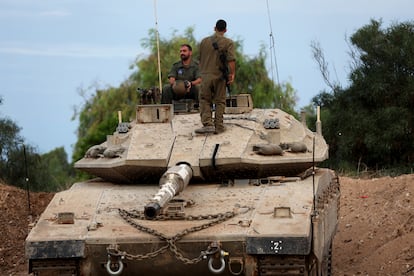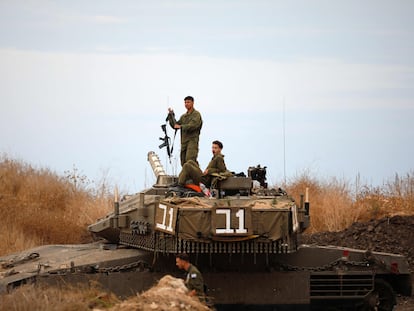Israel’s lessons in Lebanon: Two invasions failed to defeat Hezbollah and Palestinian militias
Elements of previous conflicts are being repeated in the current war, such as the suffering of civilians and the indiscriminate bombing of non-military targets


Israeli troops began to withdraw from southern Lebanon on August 14, 2006, after a month of fighting Shiite Hezbollah guerrillas and heavy bombing, during which the Israeli Air Force destroyed entire neighborhoods in southern Beirut — which the inhabitants had fled with little more than the clothes on their backs in just a few hours — as well as infrastructure throughout the country. It was the second time that the Israel Defense Forces (IDF) had entered Lebanon. On the first occasion, in 1982, it laid siege to Beirut to dislodge Yasser Arafat’s Palestine Liberation Organization (PLO) militiamen. In both cases, the Israeli army won the battle, but not the war. “Ariel Sharon’s calculations proved wrong,” writes journalist Xavier Baron in his classic book Les Palestiniens. Genèse d’une nation (The Palestinians. Genesis of a nation). “The defeat of the PLO in Beirut did not make the idea of a Palestinian state disappear.”
Nor did the blow to Hezbollah make Israel’s northern border more secure. Financed and armed by Iran and hardened in the Syrian war, where it fought on behalf of President Bashar al-Assad, the Shiite militia is stronger than it was then and — since Hamas’ terrorist incursion against Israel on October 7 — the opening of a second front constitutes a constant threat.
The ground offensive against the Gaza Strip to wipe Hamas off the map is unlike any war Israel has experienced in the past, either in the number of civilian casualties caused by the bombings or in terms of the enormous price Israeli soldiers might pay. Nor in the new weapons ranged against them, such as homemade explosive-laden drones used extensively in the wars in Ukraine and Nagorno-Karabakh and by Islamic State (ISIS). And not in the magnitude and savagery of the attack on its territory, which has brought down the foundations of its security edifice.
But many other elements are repeated across these conflicts: the threat of an escalation in the Middle East, the enormous suffering of civilians, the indiscriminate bombing of non-military objectives and the dangers faced by a regular army in the hell of urban warfare fighting in enemy territory. This summer marked the 30th anniversary of the Battle of Mogadishu, which Ridley Scott recounted in Black Hawk Down, and which sums up all the problems that a force, even one as powerful as the U.S. military (or the IDF in the case of Gaza), suffers when it fights a guerrilla war in an urban environment. The images of the corpses of U.S. soldiers being dragged through the streets of Mogadishu show that in urban warfare, nothing can be taken for granted.
A house on a hill in southern Lebanon sums up all these issues, even in a scenario where technology can very effectively support soldiers on the ground. The 2006 war, which killed 1,300 Lebanese and 165 Israelis, erupted after Hezbollah attacked a military vehicle in northern Israel, killing three soldiers and capturing two others. Within hours, bombs began to fall on Beirut airport, Lebanon was placed under a naval blockade and Israeli troops crossed the border. Shortly after the ceasefire, numerous journalists took to the roads of southern Lebanon to bear witness to a landscape of razed Shiite villages — the Christian settlements remained intact — stories of collective punishment of the civilian population and unexploded ordnance, under the constant observation of Israeli drones and the sporadic presence of Merkava tanks.

The village is called Hula, and it is located a few hundred meters from the border with Israel. From that house on the hill, the nearest Israeli dwellings in the middle of a landscape of cultivated fields were perfectly visible. In 1982, it was occupied by the Israeli army and for four years, the family who lived there had to take refuge in Beirut. When they returned, they found that the house had a second floor that did not exist previously. When hostilities broke out in 2006, the family fled again. But Hezbollah militiamen knew that Israeli soldiers would reoccupy the house because of its strategic position: they stationed themselves inside and waited. Eleven Israeli soldiers were killed in the ambush. Knowledge of the terrain, as demonstrated by Hezbollah, is one of the keys to urban combat. The army operating in enemy territory is always in danger, much more so if it faces a trained and prepared militia.
When EL PAÍS visited the location in the summer of 2006, the house still bore all the traces of the battle: bullet holes, shell casings, blood on the walls and floor, the living room destroyed by a grenade launcher. With a mixture of resignation and sadness, the mother of the family, Malah Suleiman, then 60 years old, showed the damage to her home. Then, in the garden, amid the intense smell of fig trees, in the same place where five Israeli soldiers were killed by a grenade during the ambush, she said: “It is very difficult to live like this.” In any urban combat, the first victim is not only the truth, but also civilians.
In 1982 and 2006, as today in Gaza, humanitarian organizations denounced widespread violations of the rules of war and international law. In all these conflicts, civilians paid an enormous price. The most horrific example were the massacres in the Palestinian camps of Sabra and Chatila, in which Christian phalangist militias murdered hundreds of civilians, mostly women and children, over two days between September 16 and 18, 1982. They were not perpetrated by Israeli soldiers, but a commission of inquiry composed of three Israeli judges determined the clear responsibility by omission of then-General Ariel Sharon because the mass murders were carried out in front of his troops, who at all times knew what was happening from their observation posts overlooking the camps.
The film Waltz with Bashir, written by an Israeli veteran of that war, Ari Folman, describes it accurately. The great French storyteller Jean Genet, who was in Beirut and visited the site of the massacre, wrote in his book The Declared Enemy: “How do the Israelis, soldiers and officers, pretend not to have heard anything, not to have noticed anything, if they occupied this building since Wednesday morning? Was Chatila massacred in whispers or in complete silence?”
The PLO moved from Beirut to Tunis — which Israel also bombed in October 1985 — but the violence was only stopped by peace agreements that are now not worth the paper they were written on. “The lesson of the past four decades,” wrote BBC analyst and journalist Kim Ghattas, one of the leading experts of the situation in the Middle East, in the Financial Times, “is also that every attempt to wipe out Palestinian armed groups has only produced more extreme iterations and worse conundrums.” Her article was titled “All involved in the Israel-Hamas conflict should heed the warnings of 1982.″ Wars don’t look alike, but mistakes repeat themselves. Meanwhile, the only thing that does not change on the ground is the growing death, destruction and hatred.
Sign up for our weekly newsletter to get more English-language news coverage from EL PAÍS USA Edition
Tu suscripción se está usando en otro dispositivo
¿Quieres añadir otro usuario a tu suscripción?
Si continúas leyendo en este dispositivo, no se podrá leer en el otro.
FlechaTu suscripción se está usando en otro dispositivo y solo puedes acceder a EL PAÍS desde un dispositivo a la vez.
Si quieres compartir tu cuenta, cambia tu suscripción a la modalidad Premium, así podrás añadir otro usuario. Cada uno accederá con su propia cuenta de email, lo que os permitirá personalizar vuestra experiencia en EL PAÍS.
¿Tienes una suscripción de empresa? Accede aquí para contratar más cuentas.
En el caso de no saber quién está usando tu cuenta, te recomendamos cambiar tu contraseña aquí.
Si decides continuar compartiendo tu cuenta, este mensaje se mostrará en tu dispositivo y en el de la otra persona que está usando tu cuenta de forma indefinida, afectando a tu experiencia de lectura. Puedes consultar aquí los términos y condiciones de la suscripción digital.
More information
Archived In
Últimas noticias
Maduro pleads not guilty before the federal court in New York: ‘I am still the president of Venezuela’
A new test can detect Alzheimer’s from a finger prick
UN team enters Sudanese city of El Fasher after paramilitary massacre: ‘It’s like a ghost town’
A recipe for resistance: Indigenous peoples politicize their struggles from the kitchen
Most viewed
- Gilles Lipovetsky: ‘If you want to live better and fall in love, take Prozac, don’t look to philosophy’
- Alain Aspect, Nobel laureate in physics: ‘Einstein was so smart that he would have had to recognize quantum entanglement’
- Alvin Hellerstein, a 92-year-old judge appointed by Bill Clinton, to preside over Maduro’s trial in New York
- Why oil has been at the center of Venezuela-US conflicts for decades
- Maduro’s downfall puts China’s relationship with Venezuela to the test










































